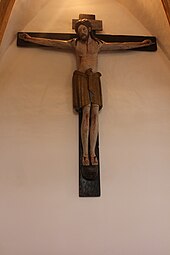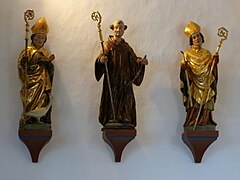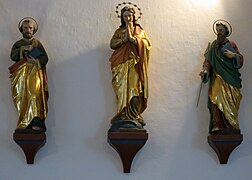Finding the Holy Cross (Enghausen)
The branch church of the Holy Cross is a branch church of the Priel parish in Enghausen (municipality of Mauern ) in the Freising district . It is known for the Enghausen Cross , which is considered the oldest larger than life crucifix and therefore the oldest monumental cross at all.
history
The church is mentioned in a document as early as 808 as “ecclesia eginonis”. The church in Enghausen was rebuilt around 1500, and the (Enghausen) cross was probably taken over from the collegiate church in Moosburg . The church has belonged to the parish of St. Johannes Baptist Priel since 1699 , previously it was incorporated into the collegiate church in Moosburg. After 1699 the tower, nave and sacristy were added. At an unknown point in time, the church in Enghausen also changed its patronage . In place of the Hl. Stephanus which entered Finding of the Holy. Cross .
In 2002, the conservation and restoration of the historic Enghausen cross began because the setting was unstable and the cross was generally very dirty. At that time, the cross was still considered a Romanesque crucifix from the end of the 12th century. The restoration then brought to light the exact age of the Enghausen Cross, it dates from around 890/900. After the completed restoration, the cross was moved back to the branch church “St. Finding the Cross ”brought to Enghausen.
Building description
Eginhusan's first church or chapel was probably made of wood, but it is unknown when the first stone structure was built. The current one probably dates from the late Gothic period before 1500. It is a bit hidden between the farms and the small, narrow tower protrudes only a little over the roofs. It looks like a somewhat higher roof turret; but it is only integrated into the nave. Its walls come down to the ground. This tower, the sacristy and the nave were not built in this form until after 1699.
Protected monument
The brief description of the list of monuments reads: “Gothic hall building with polygonal choir, roof turret and attached sacristy, probably 15th century; with furnishings “However, a distinction must be made between the late Gothic choir and the other parts of the building that were built after 1699, such as the nave, tower and sacristy. The furnishings are very important in this small branch church, because it includes the Enghausen Cross. A modern alarm system protects the small church and the precious cross.
Exterior
The exterior of the small church is very simple, especially on the north side. The south side is structured by the small porch, the sacristy and the cemetery cross hanging between two windows on the nave. The choir has not moved in, it is the width of the nave. On the west side the narrow tower is not next to the building, it is integrated into the nave. A small cemetery with a wall surrounds the branch church.
Furnishing
- High altar with Gothic lecture cross, in front of it a seated Madonna and Child, St. Magdalena on the left and St. Stephen on the right. In the tabernacle the monstrance with the particle of the cross
- St. Peter and Paul with Mary in a wreath of stars in the middle, on the right wall of the chancel (coming from side altars that are no longer in existence)
- St. Martin, St. Leonhard and St. Blasius on the left wall of the chancel (originating from side altars that are no longer in existence)
- Enghausen cross, dominating on the left side of the choir
- Large picture of the finding of the Holy Cross from the end of the 19th century on the left wall of the nave
- 14 small baroque cross-path signs
- Four votive tablets (dated 1635 to 1851), including the oldest one of "Johann homair" and his family
- Three bells (medium and large bell, cast by Will in Bruckberg in 1950, bell for the poor souls), rung regularly for the Angelus prayer and by the sacristan when the storm approaches
Local history
A large fragment from the bombing of Enghausen in February 1945 hangs under the gallery. It recalls (together with a newspaper article and the death picture of a woman) of the destruction of many house roofs by the bombs and the killing of a peasant woman by the fragmentation effect of the bombs.
literature
- Enghausen. Branch church of the discovery of the cross. Late Carolingian crucifix. (= Documentation of the Archbishop's Ordinariate Munich, restoration measure) Ed. By the Archbishop's Art Department, Issue 1, 2006.
- Sylvia Hahn: Cross and Crucifix. Sign and image. On the occasion of the exhibition “Cross and Crucifix. Signs and Images ”in the Diözesanmuseum Freising, February 20 to October 3, 2005, Lindenberg im Allgäu 2005. 375 pages, ISBN 3-89870-217-0
- Hans Rohrmann: Early Benedictine large-scale sculpture north of the Alps? The crucifixes in Enghausen, Schaftlach and Schlehdorf. In: Yearbook of the Association for Christian Art in Munich 23 (2006), pp. 68–80.
Web links
- St. Michaelsbund website accessed on July 22, 2018
Individual evidence
- ↑ a b Festschrift on the return of the restored cross to the Enghausen church , May 6, 2006.
- ↑ Enghausen. Branch church of the discovery of the cross. Late Carolingian crucifix. (= Documentation of the Archbishop's Ordinariate Munich, restoration measure) Ed. By the Archbishop's Art Department, Edition 1, 2006. p. 3
- ↑ Herrmann Bauer u. Berhard Rupprecht: Art travel guide Bavaria south of the Danube. 1973, p. 371.
- ↑ List of monuments for walls (PDF) at the Bavarian State Office for Monument Preservation
Coordinates: 48 ° 32 ′ 18 " N , 11 ° 54 ′ 27" E







